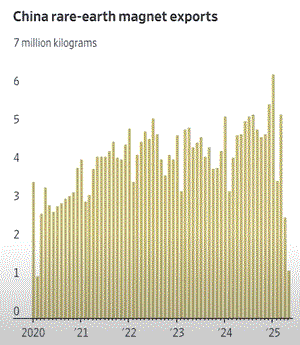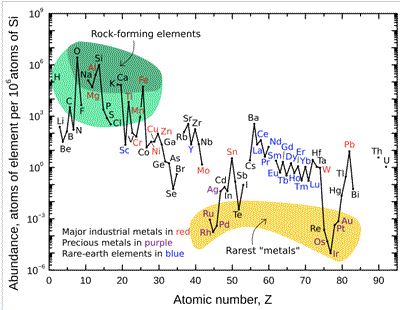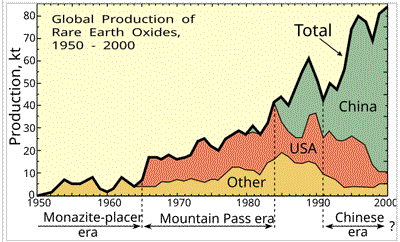>Top 1.GVS Deep Dive (2025/6/22)
https://www.youtube.com/watch?v=sz9NbB4v58k (2025/6/22)
- Every time Israel is under attack, you hear about the Iron Dome. For us, it's a national security challenge because rare earths go into almost every form of defense technology from fighter jets and warships to missiles and tanks.
- (Caster) Welcome to GBS deep dive. I'm Neesh Minhas. When China imposed its rare earth export restrictions in April 2025, many in the West dismissed it as economic posturing*3 by the country. But as the conflict across Gaza, southern Lebanon, and now Iran deepens, Israeli weapon systems are beginning to falter*4 under sustained pressure of heavy usage. It's dawning*5 on many countries, although they still do not fully comprehend that this will be a calibrated geopolitical strike, should China wish it to be. One that doesn't require a single bullet. Welcome to the 21st century warfare when minerals and not missiles may determine who wins and who never fires at all. More details on this in a few minutes.
- But you may recall that earlier this month there was an uproar in the US as manufacturers, particularly automobile manufacturers, but also from other industries started thinking about closing down production lines because of a scarcity in the rare earth minerals. Magnet they needed, magnets they did not have. The rare earth materials became the key point in the second round of discussions between the US and China in the London talks. In fact, it was the Chinese dominance in those materials that actually got the US negotiators to come back quite literally with their tails between their legs*6. Not over tariffs, not over TikTok or chips, but over magnets. Post those talks, China has allowed limited, albeit*7 still tightly controlled, rare earth exports under strict licensing rules.
- According to the Wall Street Journal's analysis recently done of customs data in May 2025, China's rare earth magnet exports plunged*8 74% year on year with the shipments to the US down by 93%. And this is following the April licensing regime introduction. Now, this is the sharpest 1-month collapse in rare earth magnet exports since 2012 from China. The global supply chain didn't just bend, it basically snapped*9. The 1.2 million kg of rare earth magnets that are exported in May marked their lowest level since February 2020 during the Covid pandemic at the time. We know that the majority of the US imports of these rare earth materials comes from China. In fact, over 70% overall. However, in April 2025, when China updated its export control law, interestingly, in the context of today's topic, it explicitly banned rare earth minerals from being used or exported by military end use or to military end users unless granted special state level authorization. Chinese companies like JL MAG Rare earth and China Northern Rare Earth Group, which received export licenses recently from the country, are still effectively barred from selling to arms manufacturers or defense subcontractors unless the buyer demonstrates pure civilian use. It's not a gray zone. Beijing's licensing language is very precise. No material can be exported if its use in military applications cannot be excluded. This means defense giants like Lockheed Martin, Raphael, Northrup Grumman among others are out of bounds.
- Let's be clear, this wasn't a blanket ban. It was a precise cutting off raw rare earth exports specifically for military use. There's a critical distinction because virtually every modern weapons platform from the chips in missile guidance systems to the magnets in fighter jet engines all rely on these rare earth elements and most of those are either mined, refined, or dominated in processing by China. So for example briefly the US government's own research shows how tantalum (Ta) which is not a rare earth material as such but is another very critical material that's crucial for jet turbines in military aircraft is not mined in the US but most of its supply comes into the country after being refined in China. It's actually mined in Congo which has the largest tantalum
mines but it gets labeled as a conflict material due to the origin and this is strict import laws both in the US and EU, and it
isn't only the material that is crucial for the US.
- There are several rare earth materials including neodymium (Nd). dysprosium (Dy), and samarium (Sm) which can go into engines, sensors, radars from fighter jets, navy ships to submarines and so on. From smart bombs to stealth jets, every modern battlefield advantage runs through a supply chain that ends in China. This is clear US industrial fragility. As the US government accountability office has reported, domestic rare earth element refining is under 10% of all military demand. Missile production capacity is below 30% of what's needed in a sustained war. But no country is feeling the effects of this supply chain trans strangle*17 hold more acutely right now than Israel.
- Now coming to Israel. Israel's conflict with Iran is costing the country hundreds of millions of dollars a day according to the early estimates out. This is a high price tag even for the Israelis that will constrain its ability to conduct a lengthy war. And this is despite the fact that it receives over 3.3 billion dollars annually from the US through its foreign military financing program along with another 500 million dollars each year for cooperative missile defense systems as the Iron Dome, David Sling, and the Arrow Systems. So far in the last one and a half years, it's received over 23 billion dollars for emergency wartime aid since October the 7th attack by Hamas. According to one estimate, a war with Iran that lasts one month will cost Israel around 12 billion dollars militarily alone. And experts say that for Iran war, the biggest single cost are the interceptors that are needed to blow up incoming Iranian missiles, which alone can amount to between tens of millions of dollars a day to 200 million dollars a day.
- But then there is the rare earth that each one of those systems requires. Israel relies heavily on the US and domestic systems that require a steady supply of rare earth elements for its performance precision, and resilience in the battle. With China restricting military rare earth exports and Western stockpiles deleted by the Ukrainian war and for Israel in the ongoing Gaza conflict. Israel's now facing serious supply bottlenecks as it goes into this war with Iran. Israel's famous Iron Dome, which has so impressed Donald Trump that he said he now wants to build an equivalent one for the US called the Golden Dome. The Iron Dome batteries require radar systems built around high performance magnets. Each Tamil interceptor missile is estimated to cost between 40,000 to 100,000 dollars and it contains rare earth-based control systems that rely of neodymium (Nd) , praseodymium (Pr) , samarium (Sm), and cobalt magnets. Please excuse me when I say these names incorrectly. The number of them at the end are driving me crazy. Now, it's not just about the cost. It's about chemistry. Every single launch that Israel does drains Israel's own material supply of these reserves.
- Due to shortages, Israel has had to start rationing interceptor launches. It's prioritizing those missiles which have confirmed trajectory threats. This has increased the risk of saturation attacks getting through the Iron Dome, which is how Iran initially responded to the Israeli attacks last week. It sent over, let's say, 10 of those missiles aiming to get through the Iron Dome. If Israel had an 80% success rate of stopping them, 20% of them still got through. The David Sling*21 and AR3 are Israel's medium to long-range interceptors. The AR3 shields against the long range ballistic missiles that leave the Earth's atmosphere and they cost around 4 million dollars for every interception. It uses an infrared homing*23 system that depends on ytterbium (Yb) and it stabilized ceramics and a dysprosium (Dy) based magnets. Now these components are essential for target acquisition and heat shielding. The David Sling system, which was developed jointly by Israel and the US, can shoot down short to long range missiles, drones, and other aircraft. It costs around 700,000 dollars each time it's activated. And assuming it uses two interceptors, which is normally the minimum, launched, but you can't fire what you can't replace. The rare earths in their high temperature sensors and guidance optics without these key components like for example the thermal shielding and the killing of those vehicle sensors if that degrade or they can't be replaced.
- Unfortunately for Israel right now there is said to be a production delay at the Raphael advanced defense systems which is reportedly facing procurement delays because as we know even the European countries are facing delays from China in receiving those rare earths. The result is that missiles defense coverage gaps are growing especially as the pace of those incoming Iranian strikes increases. Then coming to the mighty fight F-35 fighter jets, Israel has around 42 of them. Each one of these contains over 400 kg of rare earths. Neodymium (Nd) and samarium (Sm) for motors, cerium (Ce) for display, gadolinium (Gd) for stealth coatings, ytterbium (Yb) in the ceramic heat shields and so on and so forth*27. Without these all the repair cycles break down and the fighter's readiness obviously suffers. Now, these jets require high precision spare parts, and they're often sourced via the US and the EU supply chains that depend on Chinese processed rare earths, which as we now know are short supply to these countries. Maintenance is delayed. Fewer jets are mission ready at any given time. Training flights are said to have been reduced to preserve any component life cycles.
- Now, all of this has been highlighted after a leaked Knesset*28 briefing document which estimated that Israel could run out of key interceptors within 10 to 14 days. With the US missile replenishment* also being limited, we are actually seeing a massive impact due to these raw material shortages on military equipment. Brings us to an interesting rare moment. Let's speculate for a moment. Peace by depletion. Now, if Western nations cannot manufacture those missiles or their jets and they cannot fight, China then didn't end the war with soldiers. It did it with supply chain leverage. Share with me your thoughts on this. Have a great day.
|
- イスラエルが攻撃を受けるたびに、Iron Domeの話題が聞くことでしょう。希土類は戦闘機や軍艦からミサイルや戦車まで、あらゆる防衛技術に使用されているため、これは国家安全保障上の課題です。
- <News caster> GBS Deep Dive番組へようこそ。Neesh Minhasです。2025/4/に中国が希土類輸出制限を課した際、西側諸国の多くはこれを中国の経済制裁だと見なしました。しかし、ガザ地区、南レバノン、そして今やイランを巡る紛争が深刻化するにつれ、イスラエルの兵器システムは継続的な大量使用による圧力に弱体化し始めています。多くの国々が、これが中国が望むならば、綿密に計画された地政学的攻撃となることをまだ完全には理解していないものの、弾丸を一切必要としない攻撃となることを、ようやく理解し始めています。ミサイルではなく全く発砲しない鉱物資源が勝敗を分ける21世紀の戦争の形です。これについては、後ほど詳しく説明します。
- しかし、今月(2025/6)初めに米国で大騒動があったことを覚えているかもしれません。製造業、特に自動車メーカーだけでなく他の産業も、希土類鉱物の不足により生産ラインの閉鎖を検討し始めています。必要な磁石がなかったのです。希土類材料は、ロンドン会談における米国と中国の第2ラウンドの協議の重要なポイントとなりました。実際、これらの材料における中国の優位性こそが、米国の交渉担当者が文字通り尻尾を巻いて戻ってくる原因となったのです。関税問題でも、TikTokやチップの問題でもなく、磁石のせいだったのです。これらの会談後、中国は厳格なライセンス規則の下で、限定的ですが、依然として厳しく管理されている希土類の輸出を許可しました。
- Wall Stree Journalが最近行った2025/5月/の通関データの分析によると、中国の希土類磁石輸出量は前年比74%減、米国向けは93%減となった。これは4月の輸出許可制度導入後のことです。これは、2012年以来、中国からの希土類磁石輸出量の1ヶ月間の急激な落ち込みとなりました。世界のサプライチェーンは単に歪んだだけでなく、事実上、断線したのです。5月に輸出された120万kgの希土類磁石は、新型コロナウイルス感染症のパンデミックが続いた2020/2/以来の最低水準を記録しました。米国が輸入するこれらの希土類材料の大部分は中国から来ています。実際、全体の70%以上が中国から来ています。興味深いことには、2025/4月/に中国が輸出管理法を改正した際、.この話題に関連して、国家レベルの特別な許可がない限り、軍事目的での使用または軍事エンドユーザーへの希土類鉱物の使用または輸出が明らかに禁止されました。中国から最近輸出許可を取得したJL MAGレアアースや中国北方希土集団などの中国企業は、購入者が純粋な民生用途を証明しない限り、依然として武器メーカーや防衛関連の下請企業への販売を事実上禁じられています。これはグレーゾーンではありません。北京のライセンス規定は非常に明確です。軍事用途への使用を排除できない限り、いかなる物質も輸出できません。即ち、Lockheed Martin、Raphael、Northrup Grumman といった防衛産業大手は輸出対象外なのです。
- 明確なのは、これは全面禁止措置ではなく、軍事用途に特化したレアアース原料の輸出を厳密に停止した措置だということです。ミサイル誘導システムのチップから戦闘機エンジンの磁石に至るまで、事実上あらゆる現代兵器の基盤はこれらの希土類元素に依存しており、そのほとんどは中国で採掘・精製・加工されているからです。例えば、米国政府自身の調査によると、厳密には希土類ではありませんが、軍用機のジェットタービンに不可欠な非常に重要な材料であるタンタル (Ta)は、米国では採掘されておらず、その供給の大部分は中国で精製された後に米国に輸入されていることが明らかになっています。実際には、タンタル鉱山が世界最大規模を誇るコンゴで採掘されていますが、その産地から紛争鉱物と指定されており、米国とEUの厳格な輸入規制を受けています。さらに米国にとって重要材料はタンタルだけではありません。
- ネオジム (Nd)、ジスプロシウム(Dy)、サマリウム(Sm)などは、戦闘機、艦艇、潜水艦などのエンジン、センサー、レーダーなどに利用できる希土類元素は数多く存在します。スマート爆弾からステルス機まで、現代の戦場におけるあらゆる優位性は、中国に端を発するサプライチェーンによって支えられています。これは米国の産業の脆弱性を如実に示しています。米国会計検査院の報告によると、国内の希土類元素精製は軍事需要全体の10%にも満たず、ミサイル生産能力は持続的な戦争に必要な量の30%にも満たないのが現状です。しかし、このサプライチェーンの窒息状態の影響を、現在のイスラエルほど深刻に感じている国はありません。
- イスラエルについてですが、初期の推計によると、イスラエルとイランの紛争は、同国に1日あたり数億ドルの費用をかかっています。これはイスラエルにとっても高額であり、長期戦を遂行する能力を制約することになります。しかも、イスラエルは対外軍事援助プログラムを通じて米国から年間33億ドル以上を受け取っているにもかかわらず、Iron Dome、David Sling、Arrow Systemsといったミサイル防衛システムにも毎年5億ドルの援助を受けています。過去1年半だけでも、10/7のハマスによる攻撃以降、緊急戦時援助として230億ドル以上を受け取っています。ある推計によると、1か月続くイランとの戦争は、イスラエルに軍事費だけで約120億ドルの費用がかかるとされています。専門家によると、イランとの戦争で最も大きな費用は、イランのミサイルを迎撃するために必要な迎撃ミサイルで、これだけでも1日あたり数千万ドルから2億ドルに上ると見込まれています。
- しかし、これらのシステム各々に必要な希土類元素があります。イスラエルは、戦闘における性能精度と耐久性を確保するために、米国および国内のシステムに大きく依存しています。中国が、軍事用希土類元素の輸出を制限し、ウクライナ戦争と進行中のガザ紛争でイスラエルが保有する西側諸国の備蓄が減少する中、イスラエルは現在、イランとの戦争に突入するに当たり、深刻な原材料供給ボトルネックに直面しています。イスラエルの有名なIron Domeは、Trump大統領に強い感銘を与え、米国にもGolden Domeと呼ばれる同様のものを建設したいと発言しています。Iron Domeのバッテリーには、高性能磁石を基盤としたレーダーシステムが必要です。Tamilの迎撃ミサイル1発の価格は4万ドルから10万ドルと推定されており、ネオジム (Nd)、プラセオジム(Pr)、サマリウム(Sm)、コバルト磁石を用いた希土類ベースの制御システムが搭載されています。これら元素の名称を誤って発音した場合はご容赦ください。難しくて気が狂いそうです。問題はコストだけではありません。化学反応の問題です。イスラエルが行う打ち上げは、イスラエル自身の物質的備蓄を枯渇させています。
- 中国による希土類元素磁石の輸出:

物資不足のため、イスラエルは迎撃ミサイルの発射を制限せざるを得なくなりました。軌道上の脅威が確認されたミサイルだけを優先的に迎撃するようになったのです。これにより、Iron Domeを貫通する攻撃のリスクが高まりました。これは、イランが先週イスラエルの攻撃に当初行った対応と似ています。イランはIron Domeを貫通することを目的として、例えば10発のミサイルを発射しました。イスラエルの阻止率が80%だったとしても、20%は貫通しました。イスラエルの中長距離迎撃ミサイルは、Dvud SkubgとAR3です。AR3は大気圏を離脱する長距離弾道ミサイルを迎撃するもので、迎撃1回あたり約400万ドルの費用がかかります。イッテルビウム(Yb)と安定化セラミック、そしてジスプロシウム(Dy)ベースの磁石を用いた赤外線ホーミング・システムを採用しています。現在、これらの部品は目標捕捉と熱遮蔽に不可欠なものとなっています。イスラエルと米国が共同開発したDvid Sling Systemは、短距離から長距離のミサイル、ドローン、その他の航空機を撃墜できます。迎撃1回あたり約70万ドルの費用がかかります。通常は最小限の2基の迎撃ミサイルを発射すると想定しますが、交換できないものを発射することはできません。高温センサーや誘導光学系に使用されている希土類元素は、例えば熱シールドのような重要部品がなければ機能しません。また、車両センサーが劣化したり交換できない場合は機能しなくなります。
- イスラエルにとって残念なことは、現在、Raphael先進防衛システムの生産に遅れが生じていると言われており、報道によると調達の遅れが生じています。これは、周知のとおり、欧州諸国でさえ、中国からの希土類元素の受領に遅れが生じているためです。その結果、特にイランによる攻撃のペースが早まるにつれて、ミサイル防衛の成功率のギャップが拡大しています。次に、強力な戦闘機F-35について言えば、イスラエルは約42機保有しています。これらは1機あたり400kg以上の希土類元素を含んでいます。モーター用のネオジム(Nd)とサマリウム(Sm)、ディスプレイ用のセリウム(Ce)、ステルスコーティング用のガドリニウム(Gd)、セラミックヒートシールドのイッテルビウム(Yb)などです。これらがなければ、修理サイクルがすべて崩壊し、戦闘機の即応性は明らかに低下します。これらのジェット機には高精度の部品が必要であり、それらは多くの場合、中国産の希土類元素に依存する米国やEUのサプライチェーンを通じて調達されています。しかし、これらの国々ではレアアースの供給が不足していることは周知の事実です。メンテナンスは遅延し、任務遂行可能なジェット機の数は減少しています。部品のライフサイクルを維持するために、訓練飛行も削減されたと言われています。
- これら全ては、イスラエルの主要な迎撃ミサイルが10日から14日以内に枯渇する可能性があると推定したクネセト(議会)のブリーフィング文書が流出したことで、浮き彫りになりました。米国のミサイル供給も制限されているため、軍事装備における原材料不足による甚大な影響が出ています。これは、非常に興味深い珍しい状況です。少し推測してみましょう。いわば材料の枯渇による平和です。さて、西側諸国がミサイルやジェット機を製造できず、戦闘もできないのであれば、中国は兵士を使って戦争を終わらせたのではなく、サプライチェーンの力で終わらせたのです。これについて、あなたの考えをお聞かせください。ではまた。
|
- a
- a
- posture: 姿勢を取る, ふるまう
- falter: ためらう
- dawn: わかり始める
- with their tails between their legs: 尻尾を巻いて, しょげかえって
- albeit |ɔːlbíːit|: although
- plunge: 落ち込む <plumbum =Pb
- snap: 折れる
- a
- a
- tantalium =tantal: #73元素, Ta
- a
- a
- a
- strangle: 絞殺, 窒息
- a
- a
- a
- sling: 石投げ器
- a
- home: 自動装置で誘導する
- a
- a
- a
- and so on and so forth: その他諸々
- Knesset: Israelの国会
|



